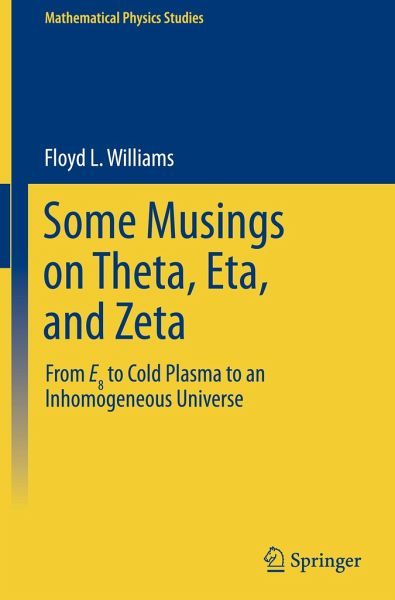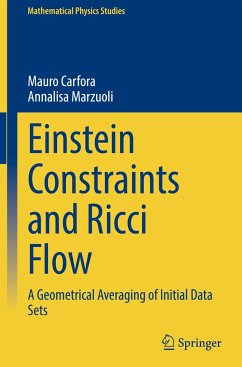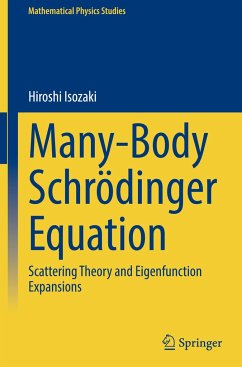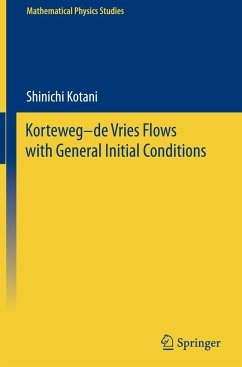
Some Musings on Theta, Eta, and Zeta
From E8 to Cold Plasma to an lnhomogeneous Universe
Versandkostenfrei!
Versandfertig in 6-10 Tagen
106,99 €
inkl. MwSt.
Weitere Ausgaben:

PAYBACK Punkte
53 °P sammeln!
This book continues the applications of mathematics, more specifically of theta, eta, and zeta functions, and modular forms, to various areas of theoretical physics. It is a follow-up and extension in some sense of the author's earlier book entitled A window into zeta and modular physics. Some of the main topics are1. A new approach to logarithmic corrections to black hole entropy2. My recent work that provides for an explicit cold plasma-black hole connection3. Generalization of work of physicists on certain asymptotic problems relating to string theory, for example, by way of the general the...
This book continues the applications of mathematics, more specifically of theta, eta, and zeta functions, and modular forms, to various areas of theoretical physics. It is a follow-up and extension in some sense of the author's earlier book entitled A window into zeta and modular physics. Some of the main topics are
1. A new approach to logarithmic corrections to black hole entropy
2. My recent work that provides for an explicit cold plasma-black hole connection
3. Generalization of work of physicists on certain asymptotic problems relating to string theory, for example, by way of the general theory of modular forms of non-positive weight
4. A construction of the E8 root lattice, its theta function, and its relevance for heterotic string theory
5. Applications of elliptic functions to KdV, nonlinear Schrödinger, and Duffing equations, for example, including a discussion of Lax pairs and the Miura transformation
6. Finite temperature zeta functionsand partition functions for quantum fields in thermal equilibrium on various curved background spacetimes
7. Exact solutions of the Einstein gravitational field equations for Lemaitre and inhomogeneous cosmological models, with a special focus on the Szekeres-Szafron exact solutions by way of the Weierstrass elliptic function
8. Elementary particles and my zeta function formula for higher spin fermionic particles; this covers, in particular, the gravitino particle (of spin 3/2) and bosons with integral spin s = 2, 3, 4, 5.
These are some sample topics. Others include the continuous Heisenberg model, reaction diffusion systems, Dirichlet and Hecke L-functions, the modular j-invariant, the computation of the one-loop effective potential for non-compact symmetric spaces, the BTZ black hole, Jacobi inversion formulas, etc.
Thus, there is a very large range of material with the first 9 chapters of preliminary, expositional background for mathematicians and physicists.
1. A new approach to logarithmic corrections to black hole entropy
2. My recent work that provides for an explicit cold plasma-black hole connection
3. Generalization of work of physicists on certain asymptotic problems relating to string theory, for example, by way of the general theory of modular forms of non-positive weight
4. A construction of the E8 root lattice, its theta function, and its relevance for heterotic string theory
5. Applications of elliptic functions to KdV, nonlinear Schrödinger, and Duffing equations, for example, including a discussion of Lax pairs and the Miura transformation
6. Finite temperature zeta functionsand partition functions for quantum fields in thermal equilibrium on various curved background spacetimes
7. Exact solutions of the Einstein gravitational field equations for Lemaitre and inhomogeneous cosmological models, with a special focus on the Szekeres-Szafron exact solutions by way of the Weierstrass elliptic function
8. Elementary particles and my zeta function formula for higher spin fermionic particles; this covers, in particular, the gravitino particle (of spin 3/2) and bosons with integral spin s = 2, 3, 4, 5.
These are some sample topics. Others include the continuous Heisenberg model, reaction diffusion systems, Dirichlet and Hecke L-functions, the modular j-invariant, the computation of the one-loop effective potential for non-compact symmetric spaces, the BTZ black hole, Jacobi inversion formulas, etc.
Thus, there is a very large range of material with the first 9 chapters of preliminary, expositional background for mathematicians and physicists.














